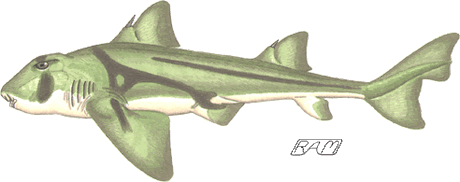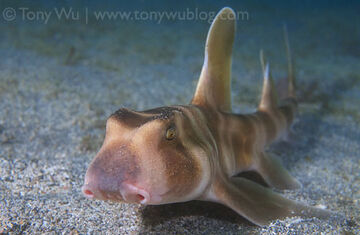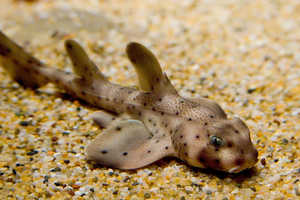
Ref: http://www.elasmo-research.org/education/ecology/id-heterodontiformes.htm
Defining Features[]
Heterodontiformes do not have many defining features that are different to that of other classifications of sharks. However, heterdontiformes have two dorsal fins, each with a spine. They also have an anal fin, five gill slits, eyes without nictitating fold, a small spiracle, and nostrils connected with the mouth by a deep grove as well.
Habitat and Range[]
Heterodontiformes are found only in marine ecosystems in a tropical or subtropical climate in continental and insular spots. They are mainly located in shallow waters in both the eastern and western Pacific Ocean and also in the western Indian Ocean.
Fisheries Conservation and Concern[]
Heterodontiformes are an order of animals that are not threatened in terms of endangerment. They are not sought after on a fishing base, and are oftentimes let back into the ocean if one is caught, and only very rarely consumed.
Closest Relatives[]
The closest relatives of Heterodontiformes are Orectolobiformes. Orectolobiformes, like Heterodontiformes, is an order of 12 carpet sharks that live in temperate, tropical waters in the western Pacific Ocean and eastern Indian Ocean. Orectolobiformes are usually found off the coast of Australia, but are not limited to just the Oceania region. There has been a species of Orectolobiformes that have been found off the coast of Japan, and also in the eastern Indian Ocean. Both of these orders are very similar in their habitat, actions, and similar in body size etc….
Example Species in Heterodontiformes[]
Japanese Bullhead Shark

Ref: http://www.tonywublog.com/journal/even-the-sharks-are-cute
Heterodontus japonicus
The Japanese bullhead shark is about 3.9 ft (1.2 m) long. The shark differentiates from others with its short, blunt head, two high dorsal fins with spines, and a pattern of irregularly shaped, vertical brown bands and stripes across its body.
This bullhead shark is mainly located in the northwestern Pacific Ocean near Japan and along the eastern coast of China to Taiwan. It usually is found at a depth of 20 - 121 ft (6 - 37 m).
Least concern (IUCN 3.1)
California Horn Shark

Ref: https://a-z-animals.com/animals/horn-shark/
Heterodontus francisci
The California Horn Shark gets to about 4 ft (1.22 m) long. This shark, like the bullhead shark, has a short, blunt head, but has high ridges above their eyes and also large fin spines, including 2 prominent dorsal fin spines as well.
The California Horn Shark is mainly located in the eastern Pacific Ocean near California, hence the name, and lives in kelp forests no deeper than 40 feet.
The California Horn shark is listed as Data Deficient by the IUCN, but is most likely to be of least concern like the Japanese bullhead shark.
References[]
https://www.pbs.org/wgbh/nova/sharks/world/heterodontiformes.html#:~:text=Habitat%3A%20Shallow%20to%20moderately%20deep,western%20and%20eastern%20Pacific%20oceans.
https://www.encyclopedia.com/environment/encyclopedias-almanacs-transcripts-and-maps/heterodontiformes-bullhead-or-horn-sharks
https://www.fishbase.in/summary/741
https://www.montereybayaquarium.org/animals/animals-a-to-z/horn-shark
https://www.iucnredlist.org/species/161714/124532497
https://www.iucnredlist.org/species/39333/80671300
https://www.sciencedirect.com/topics/agricultural-and-biological-sciences/orectolobiformes